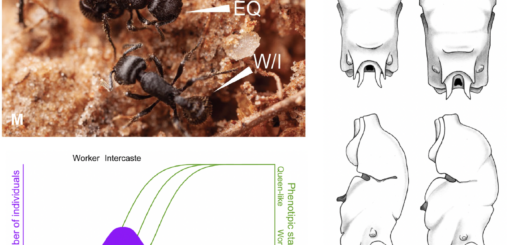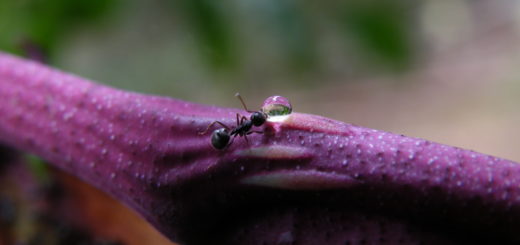How to dissect a superorganism
In the recently published paper “Temporal variation in social structure and worker reproduction in the temporary social parasite Lasius fuliginosus (Hymenoptera: Formicidae)“, Tobias van Elst and Jürgen Gadau reveal that colonies of L. fuliginosus are mainly monogynous and facultatively polyandrous. Furthermore, they also observed that males are produced by workers, for the second time in the genus Lasius, beside L. niger. In this Review, Christina Kwapich emphasizes their main points.
A Review compiled by Christina L. Kwapich 
Like the body of a traditional organism, an ant colony is composed of a hierarchy of specialized parts, best understood after careful dissection. For those interested in the ecology of social organization, comparing the physical attributes of numerous colonies (sociometry) is a fail-proof method for generating fresh hypotheses (Tschinkel 2010). Of course, the measurable qualities of any society are not limited to the parts we can see, and over the last few decades, DNA fingerprinting has revealed an unexpected variety of hidden genetic structure within individual nests. While most ant colonies are headed by a single queen mated by a single male, we now know that a handful of workers may include more patrilines than fingers, and that two nuzzling nestmates might scarcely be sisters at all.
Depending on species and circumstance, a colony’s sociogenetic structure unfolds from the efforts of one or multiple queens (unrelated, or re-adopted daughters); mated with zero, one, or multiple males; with workers that contribute to male production, produce daughters through sib-mating or thelytoky, lack functional ovaries all together, or come from foreign nests (either as captives from intraspecific raids or as defectors of their own volition). As dizzying as it seems, identifying unexpected genetic architecture within colonies has broadened the conversation on relatedness, cooperation and conflict in animal societies. Patriline number, for instance, has been linked to characteristics ranging from colony size, worker size (Hughes & al. 2003), and time spent foraging (Wiernasz & al. 2008), to colony growth rate, nest complexity (Kwapich & al. 2018), and fitness (Wiernasz & al. 2004). That is why I was excited to see van Elst & Gadau (2018) tackle the sociogenetics of one of the best-known and most charismatic ants in the Palearctic, Lasius fuliginosus.
Either because of its conspicuous foraging trails or an uncommon concentration of co-occurring myrmecologists, the accumulated natural history of L. fuliginosus has grown steadily over the past three centuries. Beginning with Wasmann (1892), researchers took note of the charming myrmecophiles found with these shining black ants, from various staphylinid (Akino 2002) and nitidulid beetles (Hölldobler & Kwapich 2017), to nearly a dozen mites (Khaustov 2016). Not content with simply being parasitized, L. fuliginosus is itself a hyperparasite of L. umbratus (a temporary parasite of L. niger) (Seifert 2007). The massive carton nests of L. fuliginosus can fill an entire tree and are bound together by fungal mycelia, fed with secretions gathered from aphid associates (Maschwitz & Hölldobler 1970, Schlick-Steiner & al. 2008). Foraging takes place on a network of trails reinforced by hindgut secretions (Kern & al. 1997), plagued by the aforementioned army of sneaky beetles (Hölldobler & al. 1981).

Lasius fuliginosus in a Lasius umbratus nest (© Birgit Schlick-Steiner and Florian Steiner)
With so much known about L. fuliginosus, it might seem to be out of secrets. Yet, van Elst & Gadau (2018) show that a largely monogynous and monandrous population includes a sprinkling of polyandrous and polygynous colonies. Using four polymorphic microsatellite loci, the authors reveal that most L. fuliginosus queens mate only once but that the private lives of certain females are more like pipefish or splendid fairy wrens. In addition to facultative polyandry and polygyny, the authors found evidence of male production by workers, representing only the second observation of worker reproduction within Lasius, a genus with more than 130 described species.
Taken together, these are exciting findings for one of the best studied ants in Europe, particularly because one could map the accumulated biology of this species on top of colony genetic structure. Curious minds are also left wondering if the degree of polyandry and polygyny varies across populations and with respect to habitat. How might population-level differences in mating frequency and queen number in L. fuliginosus compare with other favorites, like Veromessor pergandei and Pogonomyrmex californicus? Do extra queens increase colony size? Might additional patrilines increase colony vigilance with respect to invading myrmecophiles? Do queens contribute equally to worker production and reproduction?
Social insect colonies are unique because distributions of worker traits can be linked directly to whole colony performance. To answer big questions about the ecology and evolution across social insect species, we need more studies that take stock of colony attributes at every level of organization. If the European honeybee has taught us one thing, it is that many lifetimes could be spent uncovering unimagined secrets of a single species. Who knows, maybe L. fuliginosus will reveal its waggle dance soon.

Lasius fuliginosus in a Lasius umbratus nest (© Birgit Schlick-Steiner and Florian Steiner)
References
Akino, T. 2002: Chemical camouflage by myrmecophilous beetles Zyras comes (Coleoptera: Staphylinidae) and Diaritiger fossulatus (Coleoptera: Pselaphidae) to be integrated into the nest of Lasius fuliginosus (Hymenoptera: Formicidae). – Chemoecology 12: 83-89.
Hölldobler, B. & Kwapich, C.L. 2017: Amphotis marginata (Coleoptera: Nitidulidae) a highwayman of the ant Lasius fuliginosus. – Public Library of Science One 12: art. e0180847.
Hölldobler, B., Möglich, M. & Maschwitz, U. 1981: Myrmecophilic relationship of Pella (Coleoptera: Staphylinidae) to Lasius fuliginosus (Hymenoptera: Formicidae). – Psyche 88: 347-374.
Hughes, W.O.H., Sumner, S., Van Borm, S. & Boomsma, J.J. 2003: Worker caste polymorphism has a genetic basis in Acromyrmex leaf-cutting ants. – Proceedings of the National Academy of Sciences of the United States of America 100: 9394-9397.
Kern, F., Klein, R.W., Janssen, E., Bestmann, H.-J., Attygalle, A.B., Schäfer, D. & Maschwitz, U. 1997: Mellein, a trail pheromone component of the ant Lasius fuliginosus. – Journal of Chemical Ecology 23: 779-792.
Khaustov, A.A. 2016: Myrmecophilous pygmephoroid mites (Acari: Pygmephoroidea) associated with Lasius fuliginosus (Hymenoptera: Formicidae) in Western Siberia, Russia. – International Journal of Acarology 42: 92-105.
Kwapich, C.L., Valentini, G. & Hölldobler, B. 2018: The non-additive effects of body size on nest architecture in a polymorphic ant. – Philosophical Transactions of the Royal Society B-Biological Sciences 373: art. 20170235.
Maschwitz, U. & Hölldobler, B. 1970: Der Kartonnestbau bei Lasius fuliginosus Latr. (Hym. Formicidae). – Zeitschrift für vergleichende Physiologie 66: 176-189.
Schlick-Steiner, B.C., Steiner, F.M., Konrad, H., Seifert, B., Christian, E., Moder, K., Stauffer, C. & Crozier, R.H. 2008: Specificity and transmission mosaic of ant nest-wall fungi. – Proceedings of the National Academy of Sciences of the United States of America 105: 940-943.
Seifert, B. 2007: Die Ameisen Mittel- und Nordeuropas. – Verlag, Lutra, Germany, 368 pp.
Tschinkel, W.R. 2010: Back to basics: sociometry and sociogenesis of ant societies (Hymenoptera: Formicidae). – Myrmecological News 14: 49-54.
van Elst, T. & Gadau, J. 2018: Temporal variation in social structure and worker reproduction in the temporary social parasite Lasius fuliginosus (Hymenoptera: Formicidae). – Myrmecological News 27: 75-85.
Wasmann, E. 1892: Zur Biologie der Ameisengäste. – Deutsche Entomologische Zeitschrift. 36: 347–351.
Wiernasz, D., Perroni, C. & Cole, B. 2004: Polyandry and fitness in the western harvester ant, Pogonomyrmex occidentalis. – Molecular Ecology 13: 1601-1606.
Wiernasz, D.C., Hines, J., Parker, D.G. & Cole, B.J. 2008: Mating for variety increases foraging activity in the harvester ant, Pogonomyrmex occidentalis. – Molecular Ecology 17: 1137-1144.





Recent Comments